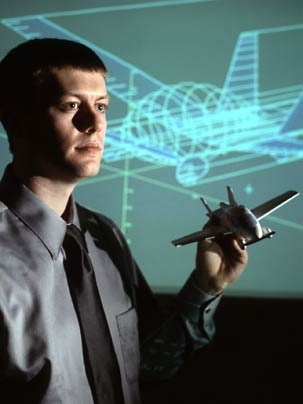The 28-year-old winner of this year's Lemelson-MIT Student Prize now has an extra $30,000 to help him get his personal flying machine off the ground.
Carl Dietrich, an MIT doctoral candidate in aeronautics and astronautics, received the prestigious award for a portfolio of novel inventions, including a new Personal Air Vehicle; a desktop-sized fusion reactor; and a lower-cost rocket engine.
"Carl joins a long line of independent inventors who are passionate about finding innovative ways to address society's fundamental problems," said Merton Flemings, director of the Lemelson-MIT Program, which sponsors the award. "He is not afraid to tackle the challenges many inventors before him have abandoned. Carl's ability to look at big problems in creative ways and come up with practical solutions makes him just the type of person we look to honor with the $30,000 Lemelson-MIT Student Prize."
Dietrich's most recent invention is a Personal Air Vehicle concept he calls Transition. It is a flying car that relies on the nation's thousands of underutilized public-access airports to provide a practical transportation alternative to travelers whose trips range between 100 and 500 miles.
"If you were taking a trip between 100 and 500 miles right now, chances are you'd probably drive unless you were going between two airport hubs," Dietrich said. "Driving is fine, but it can take you half a day to reach your destination, and you are subject to unpredictable traffic. Commercial airlines are effective for trips over 500 miles, but���they don't really attack the short-hop market very well. Personal Air Vehicles open up a lot of possibilities in freedom to get around. They offer convenience and flexibility to fit the traveler's schedule."
Dietrich's Transition is designed to be driven on any surface road and requires only a sport pilot's license to fly. The SUV-sized vehicle can be stored in most home garages and has folding wings that enable it to operate both on the ground and in the air. It can carry two people with their bags up to 500 miles on a single tank of premium unleaded gasoline.
Dietrich and four MIT colleagues have recently launched a start-up company called Terrafugia to further develop the Transition and eventually bring it to market at a price that is accessible to the traveling and business public.
"With the money from the $30,000 Lemelson-MIT Student Prize, I think we will be able to build a full-scale mock-up of the vehicle to take to the Experimental Aircraft Association's AirVenture convention in Oshkosh [Wis.]," Dietrich said. "Our goal is to make a really solid impression and start taking refundable orders."
His invention portfolio touches other fields, as well.
Dietrich co-founded the MIT Rocket Team and holds a patent for his Centrifugal Direct Injection Engine (CDIE), a low-cost, high-performance rocket propulsion engine. It operates without a turbo-pump pressurization system, which greatly reduces its complexity and cost.
For his doctoral work, Dietrich is researching inertial electrostatic confinement fusion for spacecraft power and propulsion. This research grew out of an efficiency improvement he patented for a desktop-sized Penning Fusion Reactor.
"In my 30 years as a teacher [at MIT], I cannot recall a clearer exponent of the Edison mindset," said Professor Manuel Martinez-Sanchez of aeronautics and astronautics, who recommended Dietrich for the prize. "Carl is routinely cycling back and forth between what is known and what is possible."
The $30,000 Lemelson-MIT Student Prize is awarded annually to an MIT senior or graduate student who has created or improved a product or process, applied a technology in a new way, redesigned a system, or demonstrated remarkable inventiveness in other ways. A distinguished panel of MIT alumni and associates including scientists, technologists, engineers and entrepreneurs chooses the winner.
For more information, visit http://web.mit.edu/invent.
A version of this article appeared in MIT Tech Talk on February 15, 2006 (download PDF).






